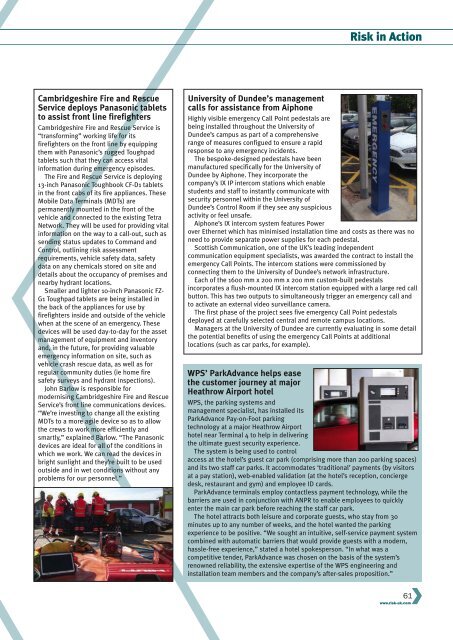RiskUKSeptember2017
Create successful ePaper yourself
Turn your PDF publications into a flip-book with our unique Google optimized e-Paper software.
Risk in Action<br />
Cambridgeshire Fire and Rescue<br />
Service deploys Panasonic tablets<br />
to assist front line firefighters<br />
Cambridgeshire Fire and Rescue Service is<br />
“transforming” working life for its<br />
firefighters on the front line by equipping<br />
them with Panasonic’s rugged Toughpad<br />
tablets such that they can access vital<br />
information during emergency episodes.<br />
The Fire and Rescue Service is deploying<br />
13-inch Panasonic Toughbook CF-D1 tablets<br />
in the front cabs of its fire appliances. These<br />
Mobile Data Terminals (MDTs) are<br />
permanently mounted in the front of the<br />
vehicle and connected to the existing Tetra<br />
Network. They will be used for providing vital<br />
information on the way to a call-out, such as<br />
sending status updates to Command and<br />
Control, outlining risk assessment<br />
requirements, vehicle safety data, safety<br />
data on any chemicals stored on site and<br />
details about the occupancy of premises and<br />
nearby hydrant locations.<br />
Smaller and lighter 10-inch Panasonic FZ-<br />
G1 Toughpad tablets are being installed in<br />
the back of the appliances for use by<br />
firefighters inside and outside of the vehicle<br />
when at the scene of an emergency. These<br />
devices will be used day-to-day for the asset<br />
management of equipment and inventory<br />
and, in the future, for providing valuable<br />
emergency information on site, such as<br />
vehicle crash rescue data, as well as for<br />
regular community duties (ie home fire<br />
safety surveys and hydrant inspections).<br />
John Barlow is responsible for<br />
modernising Cambridgeshire Fire and Rescue<br />
Service’s front line communications devices.<br />
“We’re investing to change all the existing<br />
MDTs to a more agile device so as to allow<br />
the crews to work more efficiently and<br />
smartly,” explained Barlow. “The Panasonic<br />
devices are ideal for all of the conditions in<br />
which we work. We can read the devices in<br />
bright sunlight and they’re built to be used<br />
outside and in wet conditions without any<br />
problems for our personnel.”<br />
University of Dundee’s management<br />
calls for assistance from Aiphone<br />
Highly visible emergency Call Point pedestals are<br />
being installed throughout the University of<br />
Dundee’s campus as part of a comprehensive<br />
range of measures configued to ensure a rapid<br />
response to any emergency incidents.<br />
The bespoke-designed pedestals have been<br />
manufactured specifically for the University of<br />
Dundee by Aiphone. They incorporate the<br />
company’s IX IP intercom stations which enable<br />
students and staff to instantly communicate with<br />
security personnel within the University of<br />
Dundee’s Control Room if they see any suspicious<br />
activity or feel unsafe.<br />
Aiphone’s IX intercom system features Power<br />
over Ethernet which has minimised installation time and costs as there was no<br />
need to provide separate power supplies for each pedestal.<br />
Scottish Communication, one of the UK’s leading independent<br />
communication equipment specialists, was awarded the contract to install the<br />
emergency Call Points. The intercom stations were commissioned by<br />
connecting them to the University of Dundee’s network infrastructure.<br />
Each of the 1600 mm x 200 mm x 200 mm custom-built pedestals<br />
incorporates a flush-mounted IX intercom station equipped with a large red call<br />
button. This has two outputs to simultaneously trigger an emergency call and<br />
to activate an external video surveillance camera.<br />
The first phase of the project sees five emergency Call Point pedestals<br />
deployed at carefully selected central and remote campus locations.<br />
Managers at the University of Dundee are currently evaluating in some detail<br />
the potential benefits of using the emergency Call Points at additional<br />
locations (such as car parks, for example).<br />
WPS’ ParkAdvance helps ease<br />
the customer journey at major<br />
Heathrow Airport hotel<br />
WPS, the parking systems and<br />
management specialist, has installed its<br />
ParkAdvance Pay-on-Foot parking<br />
technology at a major Heathrow Airport<br />
hotel near Terminal 4 to help in delivering<br />
the ultimate guest security experience.<br />
The system is being used to control<br />
access at the hotel’s guest car park (comprising more than 200 parking spaces)<br />
and its two staff car parks. It accommodates ‘traditional’ payments (by visitors<br />
at a pay station), web-enabled validation (at the hotel’s reception, concierge<br />
desk, restaurant and gym) and employee ID cards.<br />
ParkAdvance terminals employ contactless payment technology, while the<br />
barriers are used in conjunction with ANPR to enable employees to quickly<br />
enter the main car park before reaching the staff car park.<br />
The hotel attracts both leisure and corporate guests, who stay from 30<br />
minutes up to any number of weeks, and the hotel wanted the parking<br />
experience to be positive. “We sought an intuitive, self-service payment system<br />
combined with automatic barriers that would provide guests with a modern,<br />
hassle-free experience,” stated a hotel spokesperson. “In what was a<br />
competitive tender, ParkAdvance was chosen on the basis of the system’s<br />
renowned reliability, the extensive expertise of the WPS engineering and<br />
installation team members and the company’s after-sales proposition.”<br />
61<br />
www.risk-uk.com

















